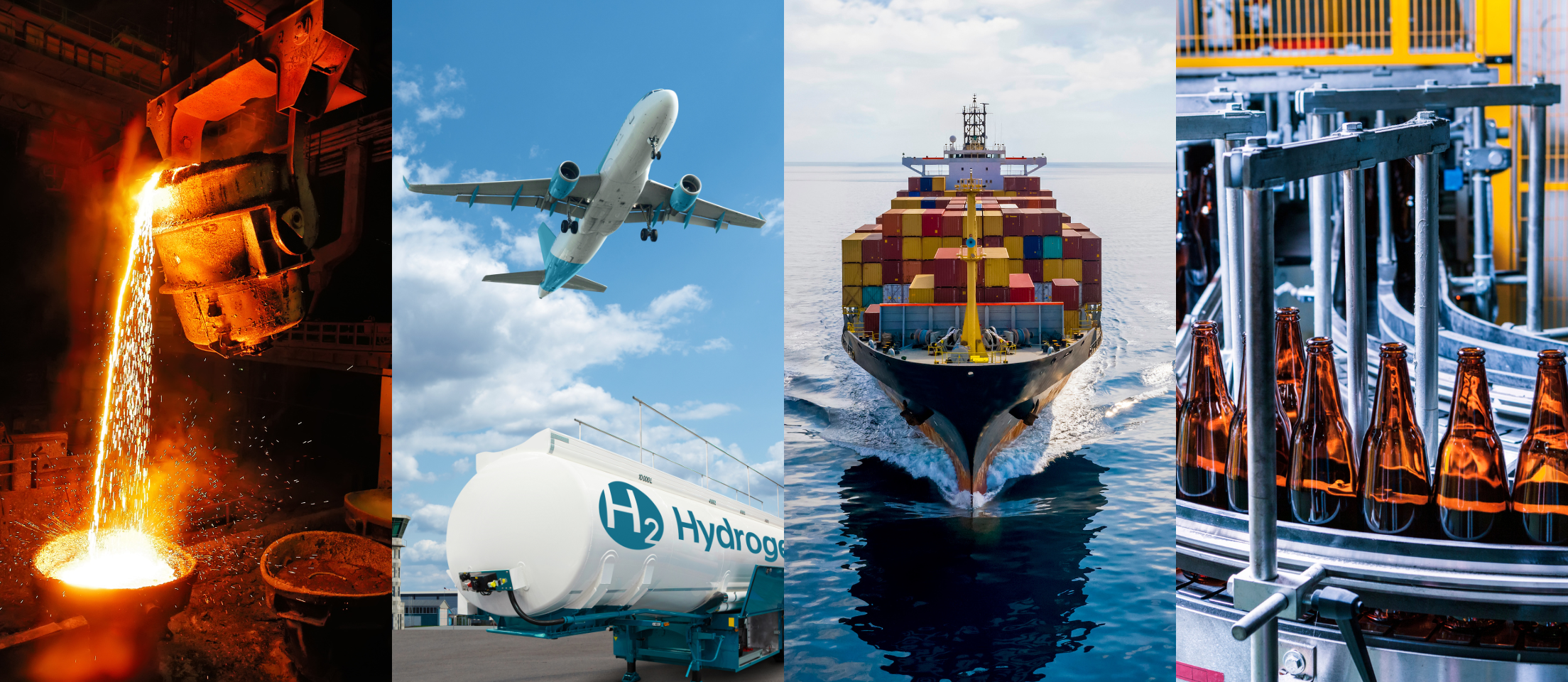Green hydrogen is a versatile solution for decarbonization. Our previous post introduced green hydrogen, highlighting its production through water electrolysis using renewable energy sources. We also overviewed the market dynamics propelling green hydrogen towards cost parity with its fossil-based counterpart, grey hydrogen. This article advances the conversation, focusing on the practical applications of green hydrogen across diverse industries and its potential to revolutionize them.
The Clean Hydrogen Ladder: Prioritizing Use Cases
The versatility of hydrogen as a decarbonization tool is akin to the multifunctionality of a Swiss Army knife. However, not all applications are equally beneficial or practical. The “Clean Hydrogen Ladder,” conceptualized by energy expert Michael Liebrich, serves as a strategic framework to evaluate and prioritize the use cases of clean hydrogen. It assesses applications based on efficiency, cost-effectiveness, safety, and the availability of alternatives, ranking them from the most viable (A) to the least (G), with G representing scenarios where hydrogen’s competitiveness is minimal. While our views on the specific locations of individual applications continuously evolve, we at NovoHydrogen appreciate the ladder framework for conceptualizing the hierarchy of most impactful and viable use cases for hydrogen from most impactful and viable to least.

Source: Hydrogen Ladder Version 5.0
Industrial Applications of Green Hydrogen
The U.S. Energy Information Administration notes that current hydrogen production is predominantly utilized in refining petroleum, fertilizer production, metal treatment and food processing. Green hydrogen stands as a sustainable alternative, poised to reduce the carbon footprint in these traditional sectors significantly.
Hard-to-abate Industrial Processes
Today, hydrogen is used in several high-heat industrial processes, such as annealing glass or steel. Hydrogen has a high flame temperature and can act as a reducing agent to remove oxygen from metal oxides during treatment, improving the quality of the final products and enhancing the efficiency and cost-effectiveness of the manufacturing processes. Additionally, electrification as a decarbonization tool may be challenging or not possible for some hard-to-abate industries.
Hydrogen is a long-term decarbonization tool for the global glass industry, as we recently detailed in Glass International Magazine. In the U.S., the glass industry emits more than 7 million annual tons of CO2.
Customer demand for climate-friendly glass is growing; in January, the Absolut Group announced that they would be the first in the global spirits industry to switch to partly hydrogen-fired glass to reduce the CO2 emissions from the making of their iconic Absolut Vodka bottles. Similarly, SCHOTT, one of the leading specialty glass companies in the world, is actively working on a climate-friendly glass production project with the goal of becoming climate-neutral by 2030. The company has launched a pilot project at its headquarters in Mainz, Germany, to test the large-scale use of hydrogen in glass-melting processes.
Steelmaking can become emissions-free by using green hydrogen as a reducing agent to convert iron ore into iron, a process that traditionally relies on carbon-based materials like coke. Recently, the Swedish steel manufacturer SSAB, in collaboration with mining company LKAB and energy company Vattenfall, has explored the use of hydrogen in steel production processes through their joint endeavor known as HYBRIT (Hydrogen Breakthrough Ironmaking Technology). The HYBRIT project began with the construction of a pilot plant in 2018 and is expected to continue with a demonstration phase from 2025 to 2035.
Transformative Impact on Transportation
In the transportation sector, green hydrogen is making strides with hydrogen fuel cells in vehicles, from trucks to ships. This technology offers an eco-friendly alternative to fossil fuels, emitting only water vapor and substantially reducing environmental impact. Hydrogen fuel cells provide a compelling case for heavy-duty and long-range transportation modes, where battery technologies may face challenges such as access to enough electricity, longer charging times, and reduced payload capacity due to heavier weights.
Nikola’s hydrogen fuel cell electric trucks, such as the Nikola Tre FCEV, represent a significant advancement in green fuel technology. The mining industry is also looking to decarbonize using hydrogen-fueled mining haul trucks, such as the one being developed by First Mode. First Mode is designing a green hydrogen solution to replace haulage trucks diesel emissions, which account for 50% of the mining industry’s emissions. Additionally, several companies are investing in green hydrogen for shipping. Among them is AP Moller-Maersk, which is poised to become one of the world’s largest consumers of green hydrogen after ordering 12 methanol-powered ships. These ships will utilize green methanol, derived from green hydrogen, as part of Maersk’s strategy to reduce its CO2 emissions and transition to cleaner fuel alternatives.
Green hydrogen can also be used in the production of alternative fuels, particularly through use as a catalyst to transform organic waste into Sustainable Aviation Fuel (SAF) and Renewable Diesel (RD). Airlines are increasingly adopting sustainable aviation fuels as a decarbonization pathway, which has nearly the same characteristics as conventional jet fuel, which means no major upgrades or retrofitting of equipment is needed. One example is Virgin Atlantic’s historic flight at the end of 2023 from London Heathrow to New York JFK, the world’s first flight fueled by 100% sustainable aviation fuel.
Evaluating Customer Needs for Green Hydrogen
Green hydrogen’s adaptability makes it a promising solution for a wide array of customer needs. At NovoHydrogen, we emphasize the importance of collaborating with customers early on to understand their decarbonization strategy and identify the most effective applications for green hydrogen. Several factors can influence the economic feasibility of a customer’s green hydrogen projects, including geography, flexibility of the blend rate, project scale, and the application of regulatory and policy incentives. In many scenarios, if renewable electricity is available, then electrification is often a more optimal alternative to decarbonizing natural gas usage.
For those considering green hydrogen’s role in their operations, our team is ready to provide insights and support. Contact us to explore how green hydrogen can be integrated into your business strategy and contribute to a more sustainable industrial landscape.

